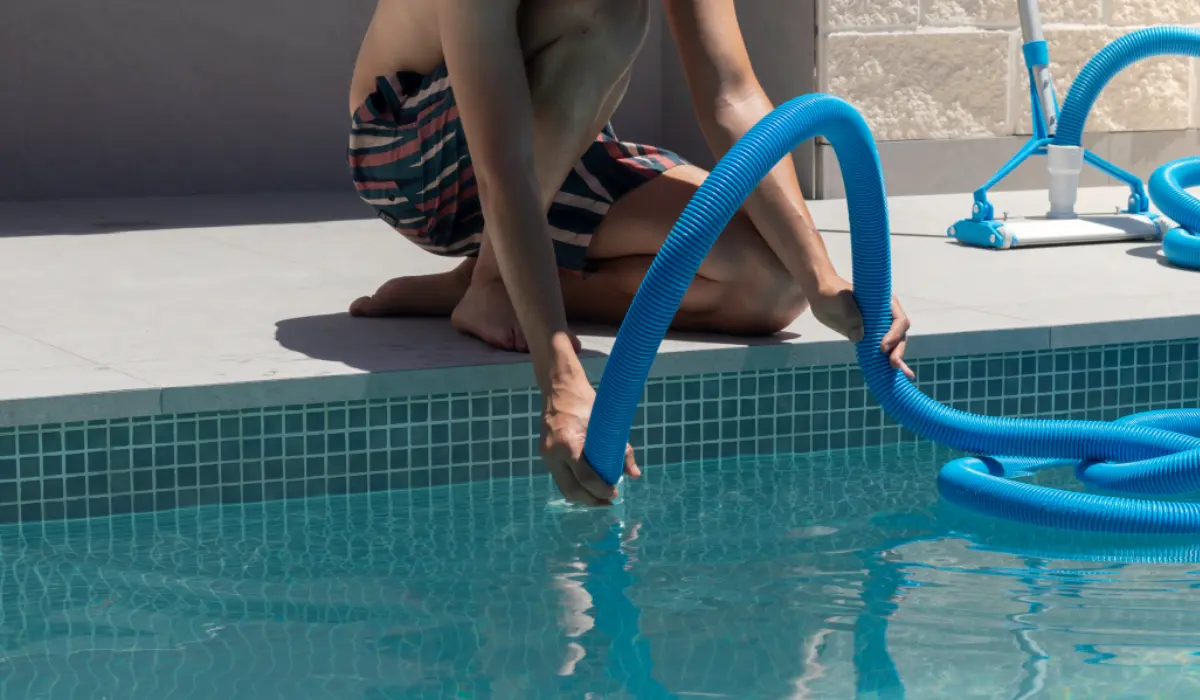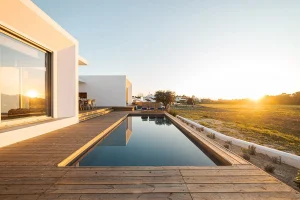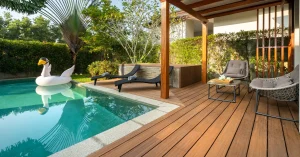Building your dream swimming pool is an exciting and rewarding endeavor. This comprehensive guide will take you through each stage of the swimming pool construction stages, providing valuable insights and tips to help you make informed decisions. So, let’s dive in!
Key
- Design and planning involves consulting a specialist, obtaining permits, and finalizing the design.
- Excavation of soil is required to shape the pool area before reinforcement with steel framing.
- Plumbing & equipment installation followed by gunite application for durability. Tile, coping & decking provide finishing touches before filling up with water & chemical balancing. Inspections ensure safety measures are met prior to start-up orientation.
The Blueprint: Design and Planning
Your new swimming pool’s journey begins with design and planning. Consulting with a design specialist, you’ll discuss your preferences, vision, and any features you’d like to incorporate into your pool. Adherence to local municipal ordinances, HOA deed restrictions, and utility setbacks are mandatory at this point for a seamless pool installation. Form boards will be used to outline the pool, adhering to the approved construction plan.
During this exciting time, you’ll finalize your pool design and receive a personalized swimming pool design proposal package. This package includes a layout that takes into account all necessary regulations, ensuring your backyard oasis is built without any hiccups.
Remember that obtaining permits for residential swimming pool zoning and construction is a vital prerequisite before moving forward. This stage ensures that your pool installation meets all local regulations and requirements.
Digging In: Excavation and Shaping
Once permits are obtained and boards approved, the real action begins: breaking ground on your pool. Armed with heavy equipment, an excavation crew will dig and shape the pool area. This stage prepares the pool site for structural reinforcement, which is essential for both concrete and fiberglass pools. Excavation typically takes one full day for a standard-sized swimming pool, but the duration can vary depending on factors such as pool size, entertainment space, and weather conditions.
The majority of the soil will be removed, while any remaining soil will be used for other stages of construction. As your backyard transforms, remember that your landscaping may experience temporary disruption. However, rest assured that once the pool is complete, your backyard will be transformed into a stunning oasis.
Reinforcement and Support: Structural Steel and Framing
With the excavation complete, it’s time to reinforce and support the pool shell with structural steel and framing. Grad 60 #3 steel rebar will be placed horizontally and vertically, forming a rigid contoured grid. Tie wires and block spacers are used to maintain the rebar’s position, ensuring the strength and stability of your swimming pool.
The significance of this reinforcement stage is paramount. It provides the necessary support for the pool shell, including the pool edge, and helps prevent issues such as cracking or sinking.
A steel and ground inspection is mandated before moving on to the next stage. This inspection ensures the reinforcement is up to code and provides a solid foundation for the rest of the construction process.
The Heart of the Pool: Plumbing and Equipment Installation
Now, we arrive at the heart of the pool: plumbing and equipment installation. This stage sees the installation of the pool’s main drains, skimmers, return lines, and other enhancements. A well-designed plumbing system is essential for optimal water circulation and energy conservation.
Pool plumbing, an essential aspect of the overall pool structure, typically involves using PVC pipes. These pipes connect.
- Filters
- Suction lines
- The skimmer
- The main drain
In addition, a return line is also attached. Location, height, and additional water features are all considered during this stage, ensuring the best circulation and water clarity for your pool.
Filtration and pool pump equipment are installed at this stage. This includes swimming pool automation systems. Gas lines are routed to the equipment location, and electrical conduits are routed for pool equipment power and pool lights. With a network of up to 12 pipes in the main trench, the plumbing system is specifically designed for each pool, based on hydraulic calculations.
Building the Shell: Gunite Application and Curing
The subsequent step involves building the pool shell with gunite, a concoction of sand, rock, and cement. Gunite offers superior structural strength and greater expansion/contraction tolerance, making it an ideal material for swimming pool construction. This stage is crucial for both concrete pools and fiberglass pools.
After applying gunite, the pool floor will have a compressive stswimming pool constructionrength of 3,000-3,500 psi. Watering the gunite thrice daily for at least a week is crucial as it aids the material in achieving its full psi strength, which may span up to two weeks.
Once the gunite has cured, the next step is interior plaster application, followed by another curing period. This stage ensures the pool shell’s durability, setting the stage for the final touches.
Finishing Touches: Tile, Coping, and Pool Decking
Now that the pool shell is complete, it’s time for the finishing touches, including tile, coping, and pool decking installation. Skilled professionals will install coping, the stone or concrete material used to cap the pool shell wall, ensuring your pool edge is both functional and attractive.
The pool decking installation timeline can vary depending on the pool’s size, complexity, and the amount of decking being laid or poured. Concrete and pavers are the most popular decking options, providing a durable and visually appealing surface for your pool area.
As your dream pool nears completion, these finishing touches truly bring your vision to life. The perfect pool awaits, with beautiful tile, coping, and decking complementing your outdoor space.
Filling It Up: Plaster, Water, and Chemical Balancing
The concluding step of pool construction involves the application of materials, like plaster, to the pool interior. Once complete, the pool is filled with water, which can take up to two full days and night cycles. Monitoring and adjusting the water chemicals as the pool fills is vital for a safe and pleasant swimming experience.
After the pool is filled, waiting at least 48 hours before diving in for the first time is recommended. During this time, the plaster cures and reaches its optimal strength and durability. Your pool should be ready for swimming after or up to at least seven days.
Finally, your backyard oasis is complete, and you can enjoy the crystal clear water and soothing ambiance of your new pool.
Landscaping and Outdoor Living Spaces
With your swimming pool complete, the focus shifts to creating beautiful landscaping and outdoor living spaces. This stage includes:
- Building the pool patio
- Planting landscaping
- Erecting fencing
- Incorporating irrigation and landscape lighting
These elements enhance the pool area and create an inviting, luxurious atmosphere for relaxation and entertainment.
If budget constraints are a concern, the outdoor living project can be divided into phases, allowing you to spread out the cost and still achieve your desired result. With careful planning and expert guidance, your outdoor living space will be a stunning extension of your home.
Inspections and Safety Measures
Inspections and safety measures are synchronized as the pool project approaches completion to confirm adherence to codes and proper functioning. A comprehensive walk-through examines the pool deck and coping, reviews safety features such as fencing and gates, and evaluates the pool liner or foundation for potential damage.
Additionally, inspections will cover:
- Drains
- Lights
- Handrails
- Ladders
- Equipment like filters, pumps, and electrical components
These safety checks not only ensure compliance with local regulations but also protect your investment and provide peace of mind.
In some areas, such as Knoxville, specific safety features are required for swimming pools, especially during new pool construction, including:
- Pool barriers
- Safety pool covers
- Exit alarms
- Self-closing, self-latching devices on doors provide direct access to the pool
Awareness of and following these safety measures is crucial in maintaining a safe swimming environment for everyone.
Dive In: Pool Start-Up and Orientation
The final stage of the swimming pool building process is the pool start-up and orientation. This stage includes the following steps:
- A service technician will check the installation of the pool.
- The pool equipment will be started to ensure everything is functioning properly.
- The technician will provide maintenance and troubleshooting guidance to the homeowner.
In this stage, the technician imparts instructions on maintaining the pool, spotting and remedying any issues, and modifying the water chemistry as required. With this knowledge, you’ll be well-equipped to care for your pool and enjoy it for years to come.
Summary
In conclusion, the swimming pool construction process is a complex and exciting journey, where your dream pool becomes a reality. From the initial design and planning to the finishing touches and safety measures, each stage plays a crucial role in creating a stunning backyard oasis. Now that you’re equipped with this comprehensive guide, you can confidently embark on your pool construction adventure and dive into the joys of pool ownership.
Frequently Asked Questions
What are the stages of building a pool?
The process of building a pool involves eight steps, starting with consulting a designer and engineer for a 3D custom design, digging, steel installation, plumbing and electrical work, shotcrete application, tile and decking installation, interior finish and finally, pool start-up.
How long do you have to wait to swim in a new pool?
After filling a new inground pool, waiting 24 to 48 hours before swimming is recommended.
If you are only adding liquid chlorine, you can safely swim after 4 hours or until the levels are at five ppm. The plaster can take up to 10 months to fully cure, so you should wait at least two weeks to ensure your safety.
What happens after rebar in a pool?
Once the rebar is installed, the pool’s plumbing can be connected with PVC pipes. This involves connecting filters, suction lines, skimmer and main drain to complete the “water works” of your pool.
The next step is to fill the pool with water. This can be done with a garden hose or a water truck. Once the pool is filled, the water must be tested.
How long does it take to excavate a swimming pool?
Excavating a swimming pool typically takes one day, preparing the site for the structure.
What is the purpose of using gunite in pool construction?
Gunite is a popular choice for pool construction as it offers superior structural strength and is less likely to suffer from damage such as cracking or sinking.



